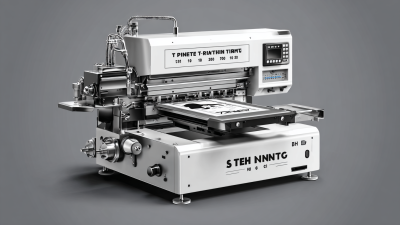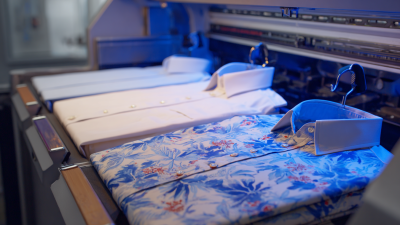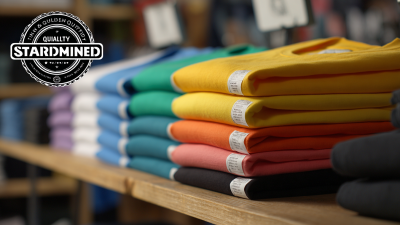The fashion industry is undergoing a remarkable transformation, driven by advancements in technology, particularly in the realm of T Shirt Printing Printer Machines. These innovative devices have revolutionized the way designers approach garment creation, allowing for greater customization and rapid production times. According to a recent report by ResearchAndMarkets, the global custom T-shirt printing market is projected to reach $3.64 billion by 2025, reflecting a growing consumer demand for personalized apparel. As these machines become more accessible to both large brands and individual creators, they empower fashion designers to experiment with new ideas without the constraints of traditional production methods. This shift not only enhances creativity within the industry but also caters to a market increasingly seeking unique and expressive clothing options. The impact of T Shirt Printing Printer Machines is significant, marking a new era in fashion design where creativity knows no bounds.

The evolution of T-shirt printing technology has revolutionized fashion design, allowing designers to push the boundaries of creativity. From traditional screen printing to cutting-edge digital printing, the advancements in technology have made it easier for artists to express their ideas on fabric. Digital printers allow for intricate designs and vibrant colors, which can be produced in small batches or even on demand, responding to the fast-paced nature of contemporary fashion.

Tips for aspiring designers include experimenting with various printing techniques to find your unique style. Whether you prefer the bold statements of screen printing or the detailed imagery of direct-to-garment (DTG) printing, understanding these methods will empower you to create designs that resonate with your audience. Additionally, utilizing software tools can help you visualize your concepts better before bringing them to life on a T-shirt.
Another important factor to consider is sustainability. Modern printing machines often use eco-friendly inks and processes, which not only reduce environmental impact but also appeal to a growing consumer base that values ethical fashion. As you embark on your journey in T-shirt design, always keep sustainability in mind to align your creations with the values of today’s conscientious shopper.
T-shirt printing machines have revolutionized the way fashion designers bring their ideas to life. With a variety of printing techniques available, each method offers unique benefits and possibilities for customization.
Among the most popular techniques are screen printing, direct-to-garment (DTG) printing, and heat transfer printing.
Screen printing is ideal for high-volume orders due to its efficiency and durability. In contrast, DTG allows for intricate designs and is perfect for small batches, offering vibrant colors and fine details.
Heat transfer printing is another versatile option that is especially useful for incorporating multiple materials and textures into a design.
Tips for achieving the best results with these printing techniques include choosing the right fabric for your design. Natural fibers like cotton typically yield better results with DTG and screen printing, while synthetic materials can work well for heat transfer methods.
Additionally, invest in high-quality inks that are suitable for your chosen printing method to enhance the longevity and vibrancy of the prints.
Lastly, don’t shy away from experimenting with different techniques; combining methods can lead to innovative designs that stand out in the crowded fashion marketplace.
When it comes to establishing a successful t-shirt printing business, the choice of printing machine is crucial. According to a report from Smithers Pira, the digital textile printing market is anticipated to reach $1.3 billion by 2024, highlighting the growing demand for high-quality, customizable apparel. With various types of printing machines available, entrepreneurs must consider factors such as production volume, print quality, and operational costs.
DTG (Direct-to-Garment) printers, for instance, provide exceptional color vibrancy and allow for intricate designs, making them ideal for small to medium-sized businesses focusing on custom orders.
Additionally, screen printing remains a popular choice for large-scale production due to its efficiency in handling bulk orders. The Specialty Graphic Imaging Association (SGIA) reports that screen printing accounts for approximately 45% of the total T-shirt printing market. For businesses looking to balance quality and output, hybrid machines that combine both DTG and screen printing capabilities might be the best option. Ultimately, selecting the right printing technology can significantly impact operational efficiency and product innovation, making it a vital consideration for any brand eyeing growth in this competitive landscape.
In the dynamic realm of fashion design, the integration of T-shirt printing technologies has become a vital tool for brands aiming to showcase their creativity. The versatility of T-shirt printing machines enables designers to experiment with various designs, colors, and techniques, allowing them to push the boundaries of traditional fashion silhouettes. This technology empowers creators to take their unique artistic visions and translate them directly onto garments, transforming a simple piece of clothing into a canvas of self-expression.
Moreover, the ease and affordability of T-shirt printing facilitate a more inclusive approach to fashion design. Small businesses and independent designers can leverage this technology to bring their ideas to life without the need for large-scale production runs. By incorporating personalized and customized designs into their fashion lines, they can cater to niche markets and reflect the individual identities of their customers. This shift not only enhances customer engagement but also fosters a deeper sense of connection between the consumer and the brand, effectively blending creativity with commercial viability in today’s ever-evolving fashion landscape.

T-shirt printing machines have revolutionized the fashion design landscape, offering aspiring designers unparalleled opportunities to express their creativity. With advanced technology, users can produce vibrant and intricate designs on fabric, enabling a unique approach to custom apparel. To maximize design potential, it's essential to understand the various printing techniques available; digital printing, screen printing, and heat transfer are the most popular methods. Each technique offers different advantages, and selecting the right one can significantly affect the outcome of your designs.
Additionally, leveraging the capabilities of design software can enhance your creative process. Tools that allow for detailed graphic manipulation can help push the boundaries of what’s possible on a t-shirt. Pairing these tools with a solid understanding of color theory and fabric types can result in a standout product that resonates with customers. Exploring different motifs and trends within the fashion industry while continuously experimenting with new designs will ensure that your t-shirt business stays fresh and relevant in a competitive marketplace.






